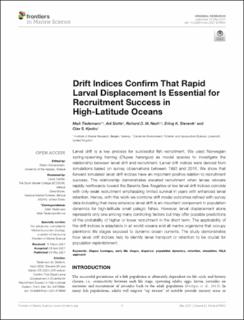| dc.contributor.author | Tiedemann, Maik | |
| dc.contributor.author | Slotte, Aril | |
| dc.contributor.author | Nash, Richard David Marriott | |
| dc.contributor.author | Stenevik, Erling Kåre | |
| dc.contributor.author | Kjesbu, Olav Sigurd | |
| dc.date.accessioned | 2021-06-03T09:32:53Z | |
| dc.date.available | 2021-06-03T09:32:53Z | |
| dc.date.created | 2021-05-25T08:14:35Z | |
| dc.date.issued | 2021 | |
| dc.identifier.citation | Frontiers in Marine Science. 2021, 8 (679900), 1-13. | en_US |
| dc.identifier.issn | 2296-7745 | |
| dc.identifier.uri | https://hdl.handle.net/11250/2757522 | |
| dc.description.abstract | Larval drift is a key process for successful fish recruitment. We used Norwegian spring-spawning herring (Clupea harengus) as model species to investigate the relationship between larval drift and recruitment. Larval drift indices were derived from simulations based on survey observations between 1993 and 2016. We show that forward simulated larval drift indices have an important positive relation to recruitment success. The relationship demonstrates elevated recruitment when larvae relocate rapidly northwards toward the Barents Sea. Negative or low larval drift indices coincide with only weak recruitment emphasizing limited survival in years with enhanced larval retention. Hence, with this work we combine drift model outcomes refined with survey data indicating that more extensive larval drift is an important component in population dynamics for high-latitude small pelagic fishes. However, larval displacement alone represents only one among many controlling factors but may offer possible predictions of the probability of higher or lower recruitment in the short term. The applicability of the drift indices is adaptable in all world oceans and all marine organisms that occupy planktonic life stages exposed to dynamic ocean currents. The study demonstrates how larval drift indices help to identify larval transport or retention to be crucial for population replenishment. | en_US |
| dc.language.iso | eng | en_US |
| dc.title | Drift indices confirm that rapid larval displacement is essential for recruitment success in high-latitude oceans | en_US |
| dc.type | Peer reviewed | en_US |
| dc.type | Journal article | en_US |
| dc.description.version | publishedVersion | en_US |
| dc.source.pagenumber | 1-13 | en_US |
| dc.source.volume | 8 | en_US |
| dc.source.journal | Frontiers in Marine Science | en_US |
| dc.source.issue | 679900 | en_US |
| dc.identifier.doi | 10.3389/fmars.2021.679900 | |
| dc.identifier.cristin | 1911565 | |
| dc.relation.project | Havforskningsinstituttet: 14861 | en_US |
| dc.relation.project | Norges forskningsråd: 299554 | en_US |
| cristin.ispublished | true | |
| cristin.fulltext | original | |
| cristin.qualitycode | 1 | |
